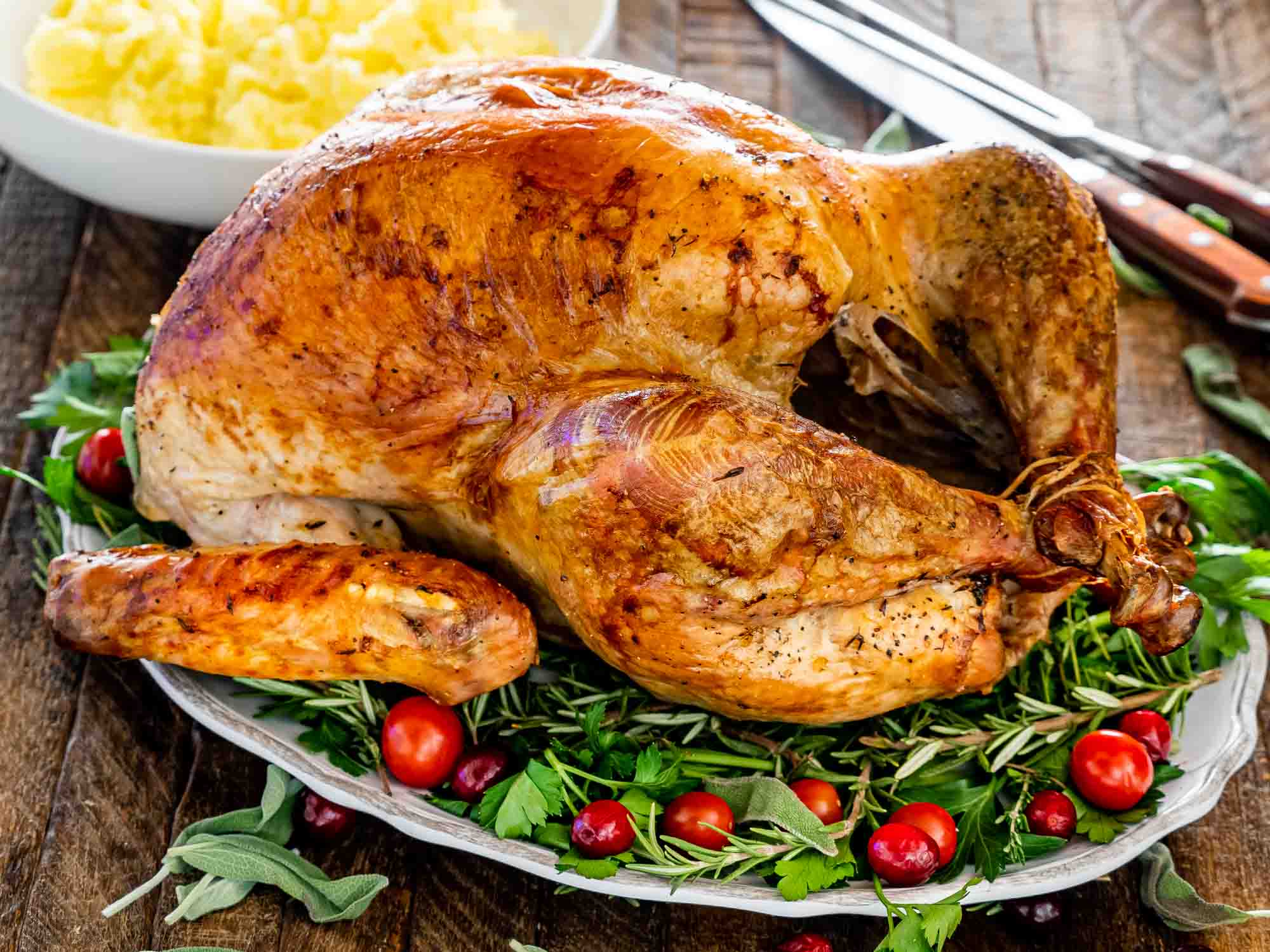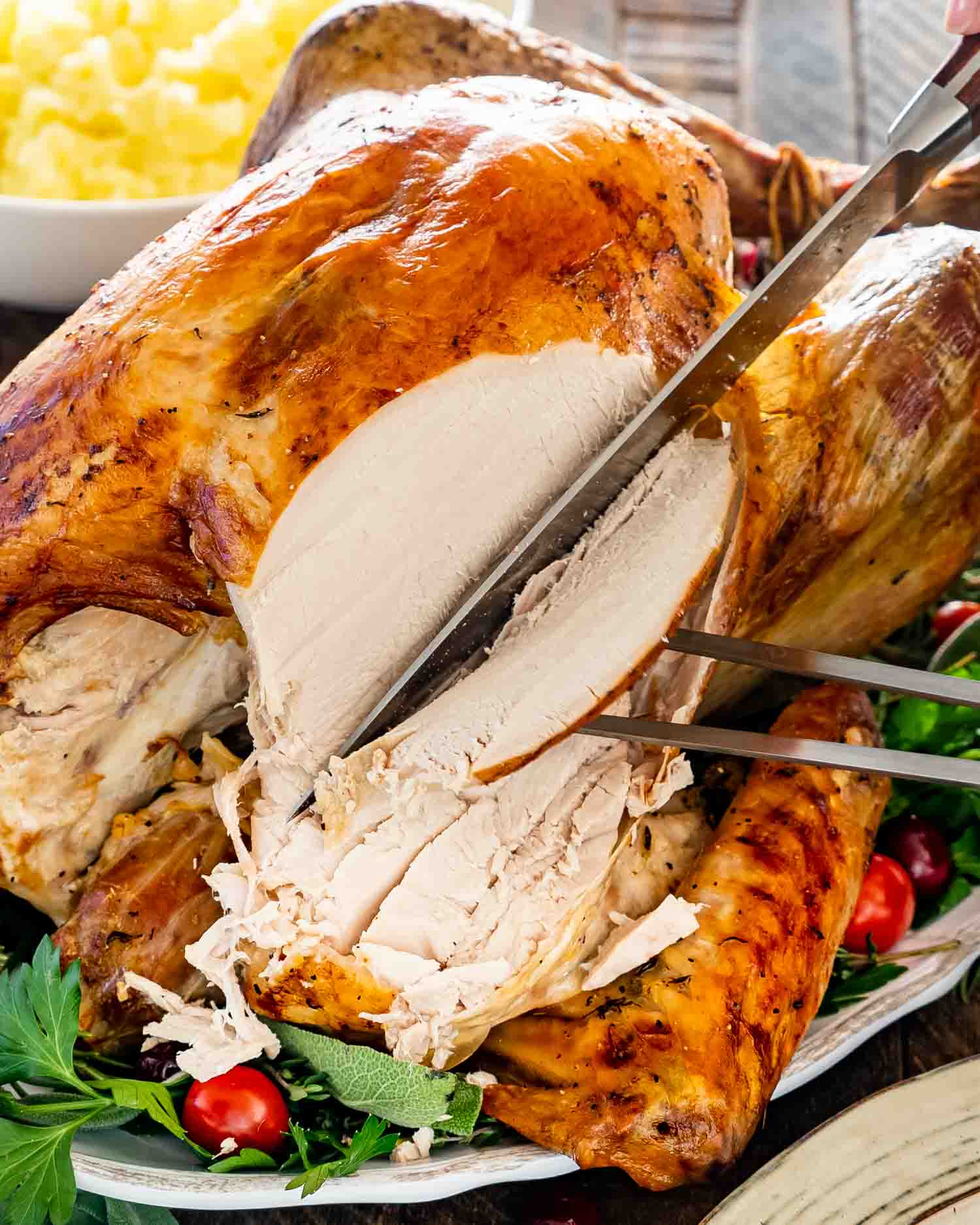How to Roast a Turkey – learn easy techniques to perfectly roast a turkey. Step by step instructions from start to finish.
Forget the traditional roasting pan – the secret to a perfectly browned, crispy-skinned turkey lies in a humble sheet pan. Yes, you read that right! This Thanksgiving, ditch the bulky pan and embrace the simple elegance of sheet pan roasting.
Why a Sheet Pan?
Traditional roasting pans are often too deep, shielding the bottom of the turkey from direct heat. This results in uneven cooking, with the breast potentially drying out while the thighs and wings remain undercooked. A sheet pan, on the other hand, allows heat to circulate freely around the entire bird, ensuring even browning and crispier skin.
The Key to Success: Elevation
To achieve maximum heat exposure, elevate the turkey on a rack placed inside the sheet pan. This allows hot air to reach the bottom promoting even cooking and a golden-brown finish. You can use a cooling rack or the V-shaped rack that comes with your roasting pan.
Benefits of Sheet Pan Roasting:
- Even browning and crispier skin: The elevated position ensures that all parts of the turkey receive direct heat, resulting in a beautifully browned and crispy skin.
- More efficient cooking: The sheet pan allows for faster heat transfer, leading to shorter cooking times and a more energy-efficient process.
- Easier cleanup: No more scrubbing a deep pan with stuck-on drippings. Simply soak the rack in soapy water for effortless cleaning.
Tips for Sheet Pan Roasting:
- Use a large rimmed baking sheet (18×13 inches) to accommodate the turkey and prevent spills.
- Place a cooling rack or V-shaped rack inside the sheet pan to elevate the bird.
- Season the turkey generously with your favorite herbs and spices.
- Baste the turkey with melted butter or oil throughout the cooking process for extra flavor and moisture.
- Use a meat thermometer to ensure the turkey reaches an internal temperature of 165°F in the thickest part of the thigh.
Embrace the Sheet Pan Revolution
This Thanksgiving, ditch the traditional roasting pan and embrace the power of the sheet pan. With its simplicity, efficiency, and ability to deliver a perfectly cooked turkey, it’s the secret weapon you need for a stress-free and delicious holiday feast.
Additional Resources:
- For a Perfectly Roasted Turkey, Skip the Roasting Pan: https://www.thekitchn.com/cook-turkey-on-sheet-pan-23478845
- The best roasting pan for your Thanksgiving turkey: https://slate.com/human-interest/2006/11/the-best-roasting-pan-for-your-thanksgiving-turkey.html
Happy Thanksgiving!
Basic Roast Turkey Recipe
Well with Thanksgiving and Christmas right around the corner, it’s time to roast a turkey. I love this season, it’s my favorite time of the year. You can’t turn on the TV without seeing a Christmas movie, and I just can’t resist watching them all. How can you not? I can watch Christmas movies all day long.
So have you roasted a turkey before? Don’t be scared, it’s just a big bird. Over the years, I’ve watched my mother roast turkeys over and over again. I love everything about roasting a turkey. The smell in the kitchen, the holiday atmosphere all around and of course, eating that delicious turkey.
This recipe here for a roast turkey is a simple basic turkey recipe. I seasoned the turkey with salt and pepper and brushed it liberally with a butter that had a lemon flavor.

Can You Cook A Frozen Turkey?
Believe it or not, you certainly can cook a frozen turkey. The sole distinction is that it will require 50% more time to cook than usual. For example, a 10 pound turkey will take about 5 ¼ hours to cook. Best way to check if it’s cooked is still to use a meat thermometer.
The turkey cooks as it thaws, with the legs and wings cooking faster. If cooking a frozen turkey, you won’t be able to do any fancy rubs or brines.

Before cooking, the turkey must be brined, which entails submerging it in a salt-water solution or dry-brining it for about a day. This results in a moist and perfectly seasoned turkey.
If you have the extra time, I strongly recommend to brine your turkey. Check out my post on Brined Roast Turkey Breast for detailed instructions on how to brine your turkey.
A dry-brine, also called pre-salting, seasons the turkey like a wet brine, but there’s no water. Essentially, you rub the meat and skin with the salt and seasonings, then let it rest in the refrigerator for a while before cooking. This works because the salt draws out the meat juices through osmosis. The brine is then reabsorbed by the meat and begins to break down the tough muscle proteins as the salt dissolves into the juices. The result is a juicy, tender, seasoned turkey.
Cooking & Kitchen Tips : How to Use a Turkey Roasting Pan
FAQ
What kind of pan should you cook a turkey in?
Do you roast a turkey in a sheet pan or pan?
What do you put in the bottom of a turkey roasting pan?
